8.4 /10 1 Votes8.4
4.6/5 My Abandonware Artist(s) Jason Piel Initial release date 1998 Developer Sierra Entertainment | 7.6/10 GameSpot | |||||||||||||||||||||||||||||||||
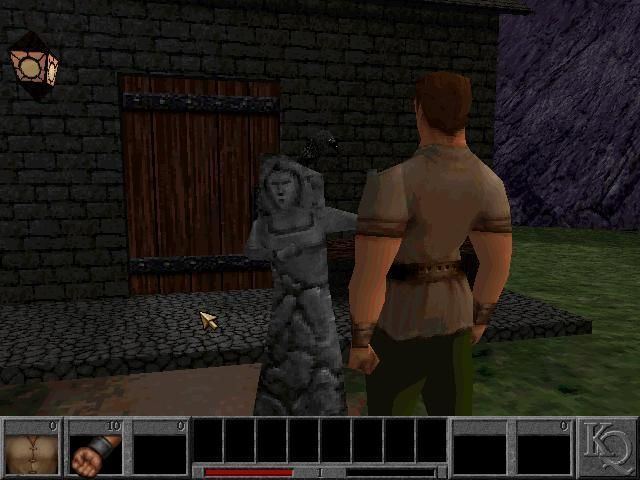 | ||||||||||||||||||||||||||||||||||
Composer(s) Ben HougeKevin MantheiMark Seibert Publishers Sierra Entertainment, Imagineer, Dice Multi Media Europe BV Similar King's Quest games, Sierra Entertainment games, Adventure games | ||||||||||||||||||||||||||||||||||
King s quest mask of eternity scarfulhu
King's Quest: Mask of Eternity (also known as King's Quest VIII: Mask of Eternity) is a hybrid point-and-click adventure and action-adventure developed and published by Sierra Studios in 1998. It was the eighth official game in the King's Quest series, the first and only game in the main series where the main character is neither King Graham nor a member of his family, as well as the first in the series to use a full 3D engine as opposed to the 2D cartoon or pixel style of the earlier games and the first to omit the sequel numbering system on box artwork and title screen.
Contents
- King s quest mask of eternity scarfulhu
- Gameplay
- Story
- Characters
- Development
- Release
- Reception
- Legacy
- References
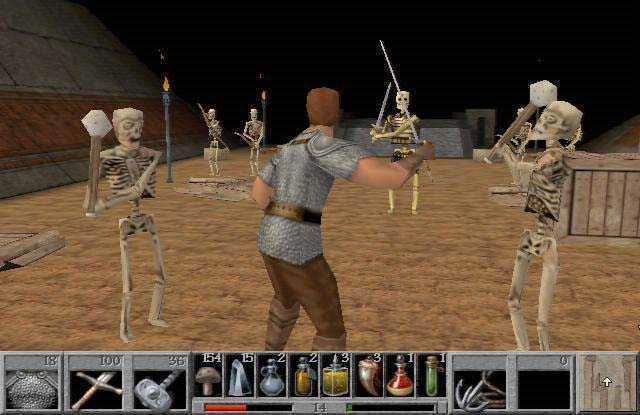
Gameplay
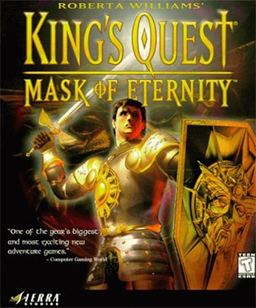
The game combines a point-and-click single multipurpose context-sensitive cursor from King's Quest VII, and a variation of the standard adventure game item inventory along the top, in addition it also includes information about total mask pieces collected, and total gold coins. Another menu along the bottom of the screen includes information concerning level, character experience, curative items, potions offering different abilities. As well as the two current weapons, and armor. On the rightside of the menu is the interface for the grappeling hook item, and rocks.
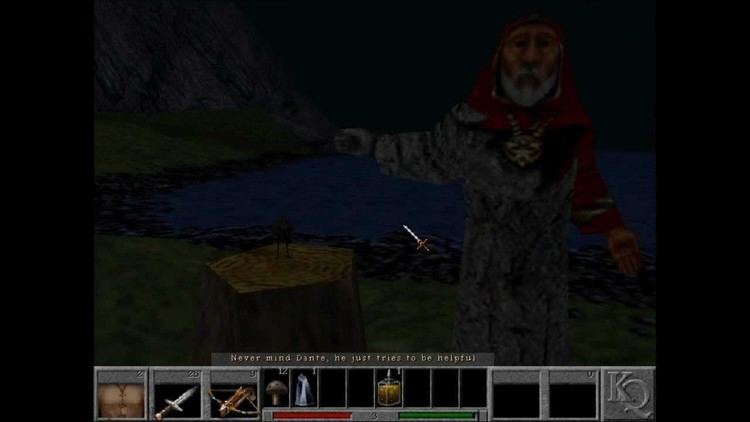
The cursor itself was dynamic, and could change into four different types of cursors depending on actions. The primary cursor is the Play Cursor, which functions much like the cursor in KQVII, it is used to; look, take, talk and do. Like in KQVII, picking up an item from inventory switches the game to an Inventory Cursor. This cursor shows an image of the item picked up, and allows the player click it on something else like in KQVII. Next is the Sword Cursor, much like the one seen at the end of King's Quest VI (during the Alhazred sword battle), it is used for combat in the game. The final cursor is the Arrow Cursor, which lets the player click on enemies from a distance, and fire projectiles.
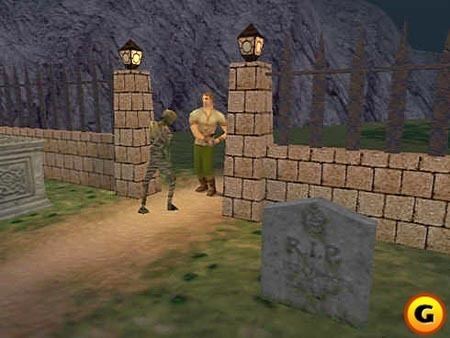
The game was designed primarily to be played in third person mode, but also offers a first person mode for those who want to use it. The first person mode was primarily put into the game, to allow players a chance to better look around or get closeups of things the screen. But it can be used to play the game in most instances, except during character interactions. There are three difficulty levels for combat (Easy, Normal, and Hard).
Story
The story begins in Castle Daventry with King Graham and his minister talking about the every day affairs of running the country, when the Magic Mirror activates in front of them showing them a bad omen. They witness Lucreto the archarchon of the Realm of the Sun destroy the Mask of Eternity and releasing a wave of energy. The mirror goes on to show the kingdom's only hope, the lowly peasant and knight, Connor of Daventry from a nearby village. He is shown chatting with his neighbor Sarah, when a storm arises and a piece of the mask falls at his feet. He picks it up, and turns around to find Sarah had been turned to stone. The unleashed magic energy turned all mortals in the world to stone, including King Graham. With that the Mirror ends its vision.
Early on in the game, the half-stone wizard that Connor encounters tells him about the Mask of Eternity, Connor's destiny, and conjures for him a magic map that shows all explored areas and allows Connor to teleport between lands once the teleportation sites in each land (except for the Realm of the Sun) have been discovered. With knowledge of his Quest, Connor made his way to Castle Daventry to check on his liege and the royal family, finding Graham and the rest of the inhabitants of the castle turned to stone. He vowed that he would save king Graham and queen Valanice, their family, and the rest of the inhabitants of Daventry, or die trying.
The game ends with Connor rising to the top of the Realm of the Sun with the restored Mask. A beam of blue light shines on the Mask, seeming to restore its power and it sends out a wave of energy that restores everything including the Kingdom of Daventry to life. Sarah is restored. King Graham newly restored looks on proudly at his hero in the Magic Mirror. The game ends with the Archons being released from their stone prisons and joining Connor who triumphantly lifts his sword into the air.
Characters
Development
Mask of Eternity went through two or three main development phases, in which Roberta Williams' ideas changed, the engine was finalized, and the graphics were finalized. In Fall 1996, Williams showed off some of her first screenshots of the game's levels, a few enemies, and the placeholder for Connor. Video showing the level development of this version of the game was included in the Roberta William's Anthology. There are scenes for two or three levels that were cut from the final game (including an undersea area, and a green forested area with a village). By July 1997, the game had gone into its final phase, and appeared much like it does in the final product. Roberta's team was forced to build a new engine from scratch based on an earlier version of 3Space (as Dynamix was behind schedule finishing the updated Red Baron II version of the 3Space engine for their own games). The first gameplay footage of this version appeared in the King's Quest Collection II. This version was completed until December 1998.
Roberta Williams classified KQ8 as either 'Adventure' or within a possible new genre, a '3D Adventure', and it went beyond traditional 'Adventures' (with maybe the exception of other hybrid adventures such as Quest for Glory, Beyond Zork and Azrael's Tear). As a '3D Adventure' it retained a point-and-click puzzle system of traditional adventure games, but also included action-adventure elements (such as avoiding traps and rolling boulders). The game includes many actions and puzzles that could only be done in 3D, many based on physics, rock tossing, jumping, climbing, or 3D combat. For example, cutting down a tree to block a river from turning the wheel on a mill, or killing an enemy so that it falls and depresses a pressure plate (alternatively a rock could be used). 3D also allowed her to expand on and focus on the exploration element which was one of the main highlights of previous King's Quest games. Other puzzles included the more traditional variety of point-and-click inventory-based puzzles seen in previous games of the series. This change or 'evolution' in the direction of adventure games was part of Roberta and Ken Williams' attempts to innovate the genre and prevent it from becoming stagnant and 'mediocre'; it represented what would have been the future of 'adventure games' had Ken Williams continued to own the company.
This was the second King's Quest game (counting the original King's Quest: Quest for the Crown (AGI release)), to not have a numeral in the title upon initial release. But it followed a pattern in several other previous Sierra games that were released with a lack of numerals but were intended to be continuations of the series. These included Quest For Glory: Shadow of Darkness (a.k.a. Quest for Glory IV), Police Quest: Open Season (a.k.a. Police Quest IV), Police Quest: SWAT (a.k.a. Police Quest V), Police Quest: SWAT 2 (a.k.a. Police Quest VI), Leisure Suit Larry Goes Looking for Love (in Several Wrong Places) (a.k.a. Leisure Suit Larry II), Leisure Suit Larry: Love for Sail! (a.k.a. Leisure Suit Larry 7), Lost Secret of the Rainforest (a.k.a. EcoQuest 2), The Beast Within: A Gabriel Knight Mystery (a.k.a. Gabriel Knight 2), and The Dagger of Amon Ra (a.k.a. Laura Bow II). Each of these games retained their numerical title within marketing materials or within the file structure (and/or manuals). References to it being the eighth game appear in the file structure (and manual) and the game was marketed as KQ8 on the official website, developer interviews and website and other places. The updated 'gamecard/boxart' for digital release now lists the game as King's Quest VIII: Mask of Eternity.
Release
Originally released in retail in 1998 and re-released in Vivendi Universal's 2006 King's Quest Collection, the game has been digitally re-released by Activision as part of the King's Quest 7+8 pack through GOG.com (September 2010) and patched to work on Windows Vista and Windows 7 32 and 64bit. Although this release was a digital download only, it has a bug and will not run unless an optical drive is present on the computer (or use of virtual drive like Daemon Tools). A fan patch is available for retail copies of the game that allows them to run on modern computers and computers without optical drives (such as a netbook), and it fixes several cutscene lockups (it is incompatible with the GoG release).
Reception
King's Quest: Mask of Eternity was released to generally positive but mixed reviews (a general improvement over the scores received by the previous game, King's Quest VII: The Princeless Bride). The controversial addition of combat mechanics into the KQ franchise was praised by many, and criticized by others. The game was one of the best selling adventures that year, outselling Grim Fandango 2-to-1. Reviews for King's Quest: Mask of Eternity tended to be positive, with most at 70% or higher, while many were above 90%, and only a few dipped as low as 10%. The game earned Adventure Game of the Year at Digital Entertainment On-line, and was nominated as the Adventure Game of the Year by Computer Gaming World (one of the finalists, losing to Sanitarium and Grim Fandango).
Legacy
King's Quest: Mask of Eternity inspired a 12-minute musical 'sequel' suite, called Daventry Suite by Donald M. Wilson, Professor Emeritus at Bowling Green State University. The multi-movement work for wind ensemble was divided into three pieces, "Sarah's Song", "Connor's Triumphal Return to Daventry", and "Celebration with Ringing Peal". Wilson's piece was featured by Sierra On-Line as "the first musical work of extended scope to be inspired by a computer game." Director of 2015's reimagined King's Quest, said Mask of Eternity is canon: "King’s Quest VIII exists. We're not doing a lot with Connor – we might have a cameo fit into it – but we're focused on the core family."
